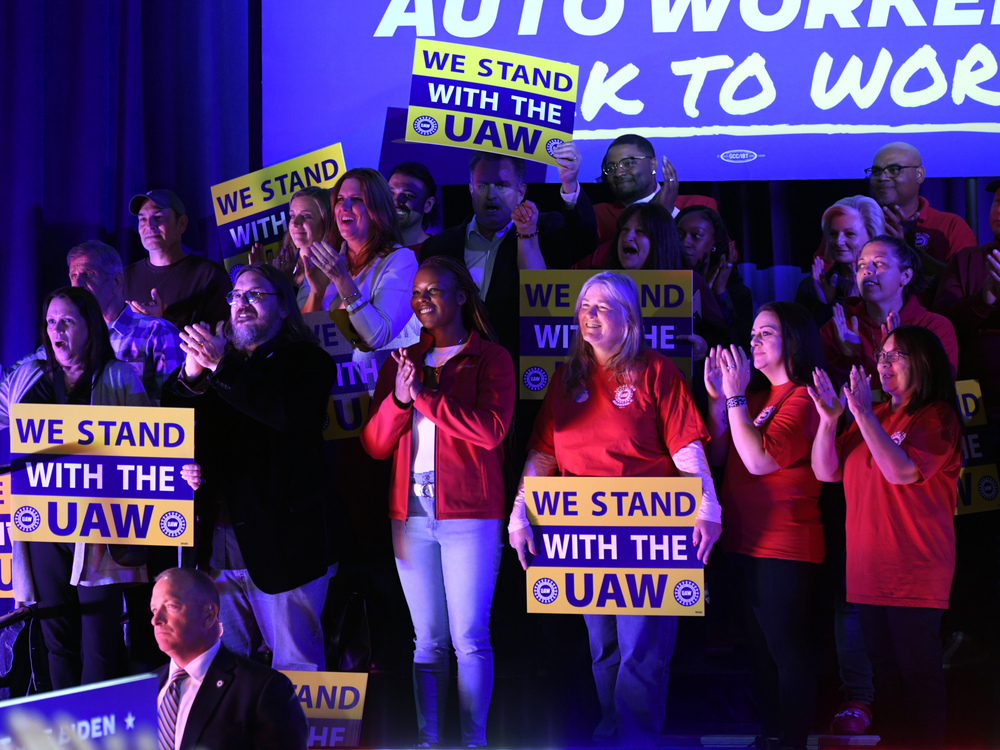
For over a decade, fears and hesitation trumped support to form a union at a Volkswagen plant in Chattanooga, Tenn. But the tide may be starting to shift, thanks to major labor victories in Hollywood and the auto industry in 2023.
"Momentum this time is way better than the first two times we've tried to unionize," said Yolanda Peoples, who works in assembly at the Volkswagen plant.
She said that's been especially true among her Black peers at the plant.
"Among African American women, there has been a boost as far as getting it organized this time," she said. "I see a big change."

Last year was a mixed bag for the labor movement. The share of U.S. workers in unions fell to 10% — the lowest since the Labor Department started collecting data on this in 1983 — largely because nonunion jobs are growing faster than union ones. At the same time, more than half a million workers went on strike, yielding big contract victories and earning the name "Hot Labor Summer."
While it is too soon to call it a labor resurgence, a new analysis from the National Partnership for Women and Families (NPWF) shows that some of the biggest labor gains came from Black and Latina women.
What the data says
The share of Black and Latina women in unions went up slightly in 2023 — from 10.3% to 10.5% for Black women and from 8.5% to 8.8% for Latina women.
While these bumps look minor at first glance, Anwesha Majumder, an economist with the NPWF who co-authored the analysis, described them as a step in the right direction, given that union membership overall has been plummeting over the years. The rate of decline was even faster for Black and Latina women until last year.
"To see that decline stop and even start to turn around a little bit feels like a really big win," Majumder said.
While Black and Latina women are leading union growth, membership fell for white women from 9.5% to 9.3% and even steeper for Asian American women from 9.1% to 7.8% last year.
Majumder said it's unclear what is exactly behind the decline for white and Asian American women, but one underlying factor could be that there were fewer Asian American women who responded when surveyed by the Census Bureau.
Meanwhile, membership rates for American Indians, Alaskan Natives, Native Hawaiians and Pacific Islanders were not included at all in numbers from the Labor Department.
Why it matters
Being part of a union can make a major difference in a woman's paycheck and quality of life, according to Majumder.
The NPWF found that among full-time Latina workers, union members made almost $14,000 more per year than their non-union counterpart in 2023. Among Black women, union members make about 20% more per week than non-union workers. For Asian American women, the difference between union and non-union members is about 7% per week.
Majumder added that along with wages, women in unions tend to have more access to benefits like flexible schedules, paid leave and health coverage. Recently, unions have also pushed for greater access to reproductive health care and gender-affirming care.
"Unions can really help reshape the workplace in a way that works for women," she said.
In San Jose, Calif., Shelsy Bass, vice president of the IFPTE Local 21, which represents public sector workers in the Bay Area, said women of color played an "instrumental role" in their bargaining wins last year, including successfully negotiating eight weeks of parental leave compared to the one week offered under their old contract.
"Some of our most compelling arguments came from women and women of color," Bass said. "I don't see how we could have done it without us."
Still more work to do
Today, men still outpace women in union membership and labor laws continue to make it difficult for some industries dominated by women of color, like domestic work, to unionize.
Peoples, the Volkswagen worker from Chattanooga, said women at her plant have been reluctant about unionizing particularly out of fear of retaliation and how it may affect their families. But seeing more women organizers on the front lines of the United Auto Workers strike against General Motors, Ford and Stellantis, has helped alleviate some of those concerns, she added.
"I believe that watching the Big Three is one of the things that changed their minds," she said. "And actually seeing more African American women standing up with the UAW too has been a changing factor."
The UAW strike won raises of at least 25% over the next four years and for some temps of as much as 168%. It's considered the biggest victory for the union in decades.
In Chattanooga, Peoples is hoping those gains will help convince a majority of workers to vote to form a union — a feat that failed twice in the past decade.







